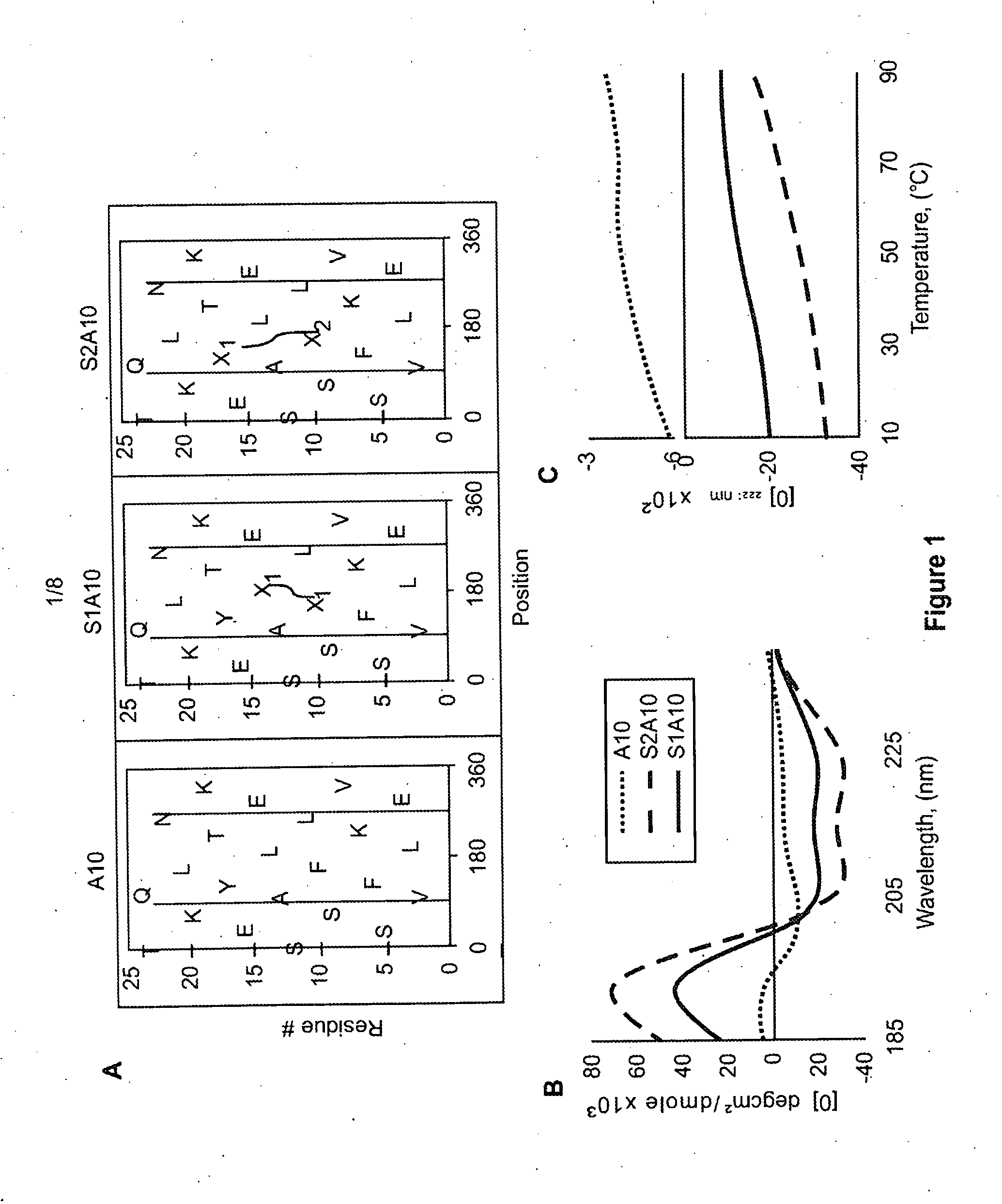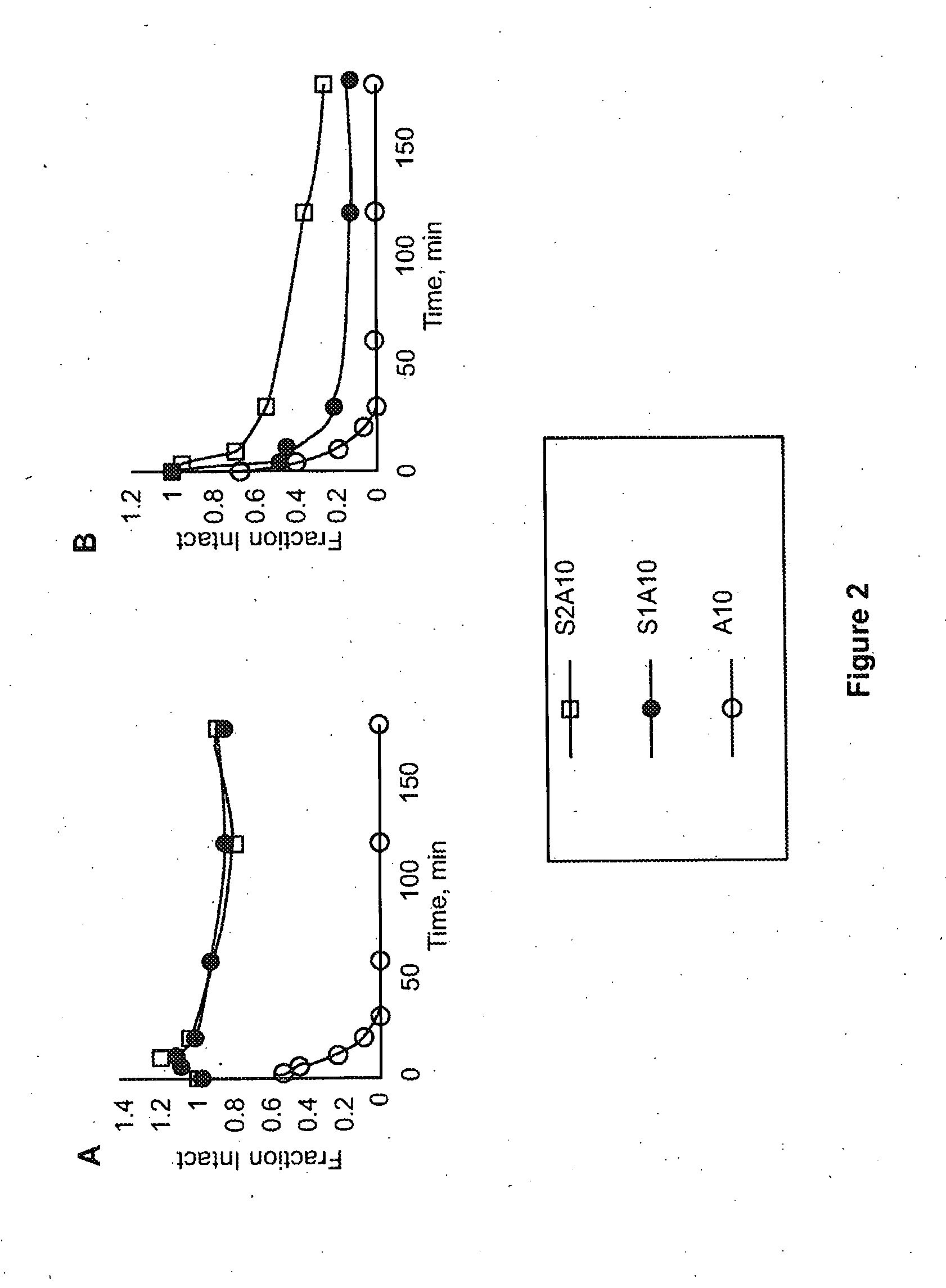Chemical modification of apolipoprotein mimetic peptides for the production of therapeutic agents
a technology of apolipoprotein and mimetic peptide, which is applied in the direction of peptides, peptide sources, peptide/protein ingredients, etc., can solve the problems of affecting the efflux ability of d4f peptide, the halting of clinical development of d4f peptide, and the cost of producing the large quantities needed for this type of treatmen
- Summary
- Abstract
- Description
- Claims
- Application Information
AI Technical Summary
Benefits of technology
Problems solved by technology
Method used
Image
Examples
example 1
Two-Site Attachment of Hydrocarbon Chains to Apolipoprotein Mimetic Peptides
[0113]The primary sequence of the last helix of apoA-I, referred to as “A10” (Ac-VLESFKVSFLSALEEYTKKLNTQ-NH2) and the position of the hydrocarbon linkers in the two modified stapled peptides, “S1A10” and “S2A10,” are shown as helical net plots in FIG. 1. Each of these peptides were made by solid phase synthesis, using standard Fmoc chemistry and the Fmoc-modified amino acid linkers ((R)-a-(7′-octanyl)Ala and (S)-a-(4′ pentenyl)Ala) (AnaSpec, Inc.)(Sviridov et al. (2011) Biochemical and Biophysical Res. Comm. 410:446-451; incorporated by reference in its entirety).
[0114]To preserve the hydrophobic moment of the modified peptides, the hydrophobic hydrocarbon staples were placed near the center of the hydrophobic region. The cross linking of the modified amino acid linkers was done by the olefin metathesis reaction with Bis(tricyclohexyl-phosphine)-benzyldine ruthenium (IV) dichloride as the catalyst. Schafinei...
example 2
Susceptibility of Stapled Peptides to Protease Action
[0118]Unfolded proteins that do not have a significant amount of secondary structure, such as alpha helices, are more readily digested by proteases, which limits the oral availability of therapeutic peptides and potentially reducing their half-life in the circulation (Bhattacharya, Zhang et al. 2008). To demonstrate the improved stability and oral availability of the stapled peptides of the invention, the 3 peptides in FIG. 1 were tested for their susceptibility to proteolysis by pepsin and chymotrypsin, which are both abundant digestive tract proteases. Several potential pepsin and / or chymotrypsin cleavage sites are found within and outside the linker region of the peptides A10, S1A10 and S2A10.
[0119]A10, S1A10 and S2A10 (5 mg / ml) were diluted 10× with either 10% acetic acid (pH 2), containing pepsin (0.5 μg / ml final) or in 10 mM NH4HCO3 (pH 7), containing chymotrypsin (0.5 μg / ml final). After incubation at 37° C., aliquots at va...
example 3
Assessment of the Ability of the Peptides to Act Like Detergents
[0121]A phospholipid vesicle solubilization assay was undertaken to assess the ability of the peptides to act like detergents. Dimyristoyl phosphatidyl choline (DMPC) vesicles were prepared by resuspension of dried DMPC with PBS and vortexing for 5 min. Changes in light scattering upon peptide addition were monitored at 24° C. every minute for 1 h at 660 nm, with shaking in a Perkin Elmer plate reader.
[0122]The unstapled A10 peptide caused some initial solubilization of the DMPC vesicles, but at later time points, the turbidity of the solution increased. In contrast, both stapled peptides readily dissolved the phospholipid vehicles (FIG. 3).
PUM
 Login to view more
Login to view more Abstract
Description
Claims
Application Information
 Login to view more
Login to view more - R&D Engineer
- R&D Manager
- IP Professional
- Industry Leading Data Capabilities
- Powerful AI technology
- Patent DNA Extraction
Browse by: Latest US Patents, China's latest patents, Technical Efficacy Thesaurus, Application Domain, Technology Topic.
© 2024 PatSnap. All rights reserved.Legal|Privacy policy|Modern Slavery Act Transparency Statement|Sitemap



